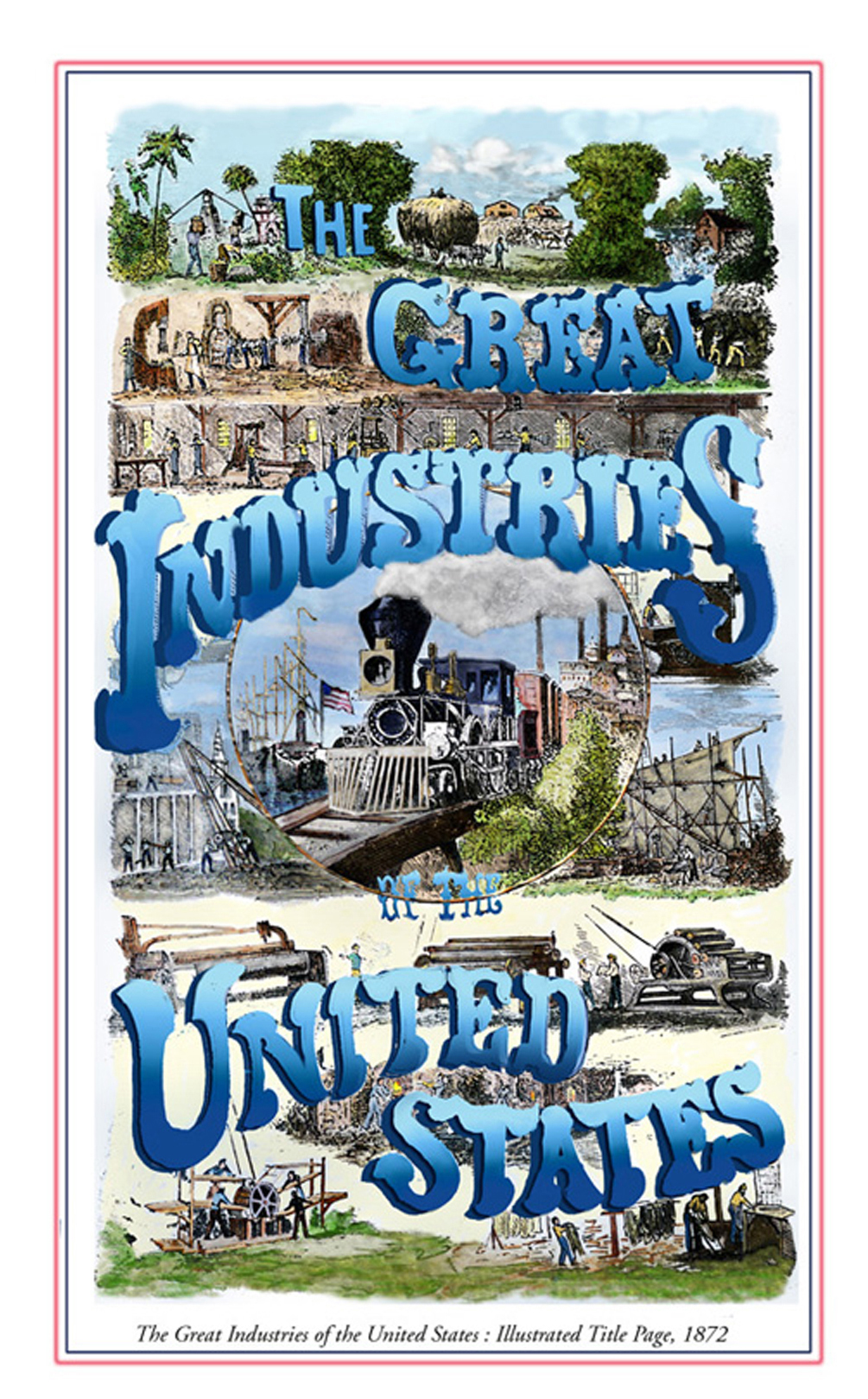
Event Timeline

The Great Industries
The Great Industries of the United States by Horace Greeley
With the dawn of the 19th century, a discernable shift occurred in the economy of the United States. Prior to that century, America had been primarily agrarian. A new era of industrialization introduced a need for the building of factories. The construction of these factories and the personnel to work in them encouraged a migration from the country to the city. In fact, it would be this migration that assisted in the establishment of new urban centers.
While agriculture would remain of continued importance, people were moving to the city in large numbers. New inventions were being created and patents established. The invention of the steam engine would lead to the building of a transcontinental railroad across the United States. On May 10, 1869 the Central Pacific and the Union Pacific Railroads joined together at Promontory Point, Utah. As the late historian Stephen Ambrose stated in his book Nothing Like it in the World; The Men Who Built the Transcontinental Railroad, “the transcontinental railroad had its watershed moment. Coast-tocoast travel time was reduced in that instant, from four to six months to six days.” Advancements in technology and the inventions that fueled those advancements solidly catapulted America into an industrial age.
With the dawn of the 19th century, a discernable shift occurred in the economy of the United States. Prior to that century, America had been primarily agrarian. A new era of industrialization introduced a need for the building of factories. The construction of these factories and the personnel to work in them encouraged a migration from the country to the city. In fact, it would be this migration that assisted in the establishment of new urban centers.
While agriculture would remain of continued importance, people were moving to the city in large numbers. New inventions were being created and patents established. The invention of the steam engine would lead to the building of a transcontinental railroad across the United States. On May 10, 1869 the Central Pacific and the Union Pacific Railroads joined together at Promontory Point, Utah. As the late historian Stephen Ambrose stated in his book Nothing Like it in the World; The Men Who Built the Transcontinental Railroad, “the transcontinental railroad had its watershed moment. Coast-tocoast travel time was reduced in that instant, from four to six months to six days.” Advancements in technology and the inventions that fueled those advancements solidly catapulted America into an industrial age.
A major promoter and supporter of this age of achievement was Horace
Greeley. From his vantage point as the Founder and Editor-in-Chief of the
New York Tribune (at a later date renamed the New York Herald Tribune)
one of the Country’s leading newspapers, Greeley had an outstanding vista
to evaluate this emerging technology. In 1871, he penned a book titled: The
Great Industries of the United States: being An Historical Summary of the
Origin, Growth, and Perfection of Chief Industrial Arts of this Country. As
the title indicates, the book identifies and emphasizes the growth of great
industries in America.
Greeley reflects on the goals of the publishers in producing this epic chronicle. In the book’s preface he says, “in the following work, the design of the publishers has been, not only to memorialize the great enterprises of manufacture of the day in the United States, but to make clear to the general reader the processes and mysteries of various manufacturers noted, as well. No pains have been spared, in the matter of general study and special investigation, to make each article as nearly perfect as necessary to convey an adequate impression of the magnitude of manufacturers treated upon, their mechanical subtitles, and everything connected therewith, of which the “inquiring mind” may properly desire to be informed.”
Greeley reflects on the goals of the publishers in producing this epic chronicle. In the book’s preface he says, “in the following work, the design of the publishers has been, not only to memorialize the great enterprises of manufacture of the day in the United States, but to make clear to the general reader the processes and mysteries of various manufacturers noted, as well. No pains have been spared, in the matter of general study and special investigation, to make each article as nearly perfect as necessary to convey an adequate impression of the magnitude of manufacturers treated upon, their mechanical subtitles, and everything connected therewith, of which the “inquiring mind” may properly desire to be informed.”
Greeley and his colleagues joint decision to (in their words) “memorialize
the great enterprises of manufacture of the United States” by publishing
The Great Industries of the United States in 1873 came just three years
before the America’s extraordinary Centennial Exposition and celebration.
The theme of the exposition was machines and the Machine Age. Horace
Greeley’s elaborate chronicle of the Industrial Age and its new technology
of that age along with the Centennial Exposition in Philadelphia would serve
to put the world on notice that the United States of America was the greatest
manufacturing, industrial producing nation on earth.
Selected Bibliography
Ambrose, Stephen. Nothing Like it in the World; The Men Who Built the Transcontinental Railroad 1863-1869.
New York: Simon & Schuster, 1998. Greeley, Horace. The Great Industries of the United States: being An Historical Summary of the Origin, Growth, and Perfection of Chief Industrial Arts of this Country. Chicago and Cincinnati: J.B. Burr, Hyde & Co., 1873.
Peter Salter Research Historian RIHiUSA,
Ambrose, Stephen. Nothing Like it in the World; The Men Who Built the Transcontinental Railroad 1863-1869.
New York: Simon & Schuster, 1998. Greeley, Horace. The Great Industries of the United States: being An Historical Summary of the Origin, Growth, and Perfection of Chief Industrial Arts of this Country. Chicago and Cincinnati: J.B. Burr, Hyde & Co., 1873.
Peter Salter Research Historian RIHiUSA,
